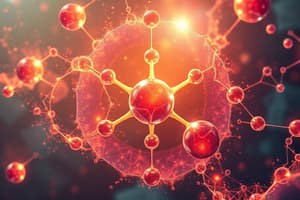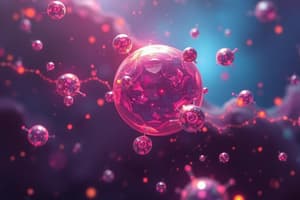Podcast
Questions and Answers
What is defined as the speed at which reactants turn into products?
What is defined as the speed at which reactants turn into products?
- Chemical Equilibrium
- Reaction Rate (correct)
- Catalytic Efficiency
- Chemical Reversibility
Which of the following best describes a catalyst?
Which of the following best describes a catalyst?
- A substance that is consumed in a reaction
- A byproduct of a chemical reaction
- A substance that slows down a reaction
- A substance that increases the rate of a reaction without being consumed (correct)
What are hydrocarbons primarily made of?
What are hydrocarbons primarily made of?
- Nitrogen and Hydrogen
- Oxygen and Carbon
- Hydrogen and Carbon (correct)
- Hydrogen and Oxygen
Which lab technique is used for separating components of a mixture?
Which lab technique is used for separating components of a mixture?
Which of the following is a fundamental guideline for chemical safety?
Which of the following is a fundamental guideline for chemical safety?
Which statement accurately reflects the definition of a compound?
Which statement accurately reflects the definition of a compound?
What distinguishes ionic bonds from covalent bonds?
What distinguishes ionic bonds from covalent bonds?
Which state of matter exhibits tightly packed particles with definite shape and volume?
Which state of matter exhibits tightly packed particles with definite shape and volume?
What is the primary role of reactants in a chemical reaction?
What is the primary role of reactants in a chemical reaction?
In the context of the periodic table, what are groups?
In the context of the periodic table, what are groups?
Which statement accurately describes a characteristic of acids?
Which statement accurately describes a characteristic of acids?
What is the unit of measurement for the amount of substance in chemistry?
What is the unit of measurement for the amount of substance in chemistry?
In thermochemistry, what is an exothermic reaction defined as?
In thermochemistry, what is an exothermic reaction defined as?
Flashcards are hidden until you start studying
Study Notes
Key Concepts in Chemistry
1. Basic Principles
- Matter: Anything that has mass and occupies space.
- Atoms: The basic unit of matter, consisting of protons, neutrons, and electrons.
- Elements: Pure substances that cannot be broken down into simpler substances (e.g., hydrogen, oxygen).
- Compounds: Substances formed from two or more elements chemically bonded together (e.g., water, H2O).
2. Chemical Bonds
- Ionic Bonds: Formed through the transfer of electrons from one atom to another, resulting in charged ions.
- Covalent Bonds: Formed when two atoms share electrons.
- Metallic Bonds: A bond found in metals, characterized by a sea of shared electrons.
3. States of Matter
- Solid: Definite shape and volume, particles tightly packed.
- Liquid: Definite volume but no definite shape, particles are closely packed but can move.
- Gas: No definite shape or volume, particles are far apart and move freely.
4. Chemical Reactions
- Reactants: Substances that undergo change.
- Products: New substances formed as a result of a chemical reaction.
- Types of Reactions:
- Synthesis: Two or more substances combine to form one.
- Decomposition: A single substance breaks down into two or more products.
- Single Replacement: One element replaces another in a compound.
- Double Replacement: Exchange of ions between two compounds.
5. The Periodic Table
- Groups: Vertical columns that contain elements with similar properties.
- Periods: Horizontal rows that represent the energy levels of electrons.
- Metals, Nonmetals, Metalloids: Categories of elements based on properties.
6. Acids and Bases
- Acids: Substances that release hydrogen ions (H+) in solution, taste sour, and can conduct electricity.
- Bases: Substances that release hydroxide ions (OH-) in solution, taste bitter, and feel slippery.
- pH Scale: Measures the acidity or basicity of a solution (0-14 scale).
7. Stoichiometry
- Mole: The unit for measuring the amount of substance, equivalent to 6.022 x 10^23 particles.
- Molar Mass: The mass of one mole of a substance.
- Conversions: Use mole ratios from balanced chemical equations for calculations.
8. Thermochemistry
- Exothermic Reactions: Releases energy (heat) into the surroundings.
- Endothermic Reactions: Absorbs energy (heat) from the surroundings.
- Enthalpy (ΔH): Total heat content of a system.
9. Kinetics and Equilibrium
- Reaction Rate: The speed at which reactants turn into products.
- Catalysts: Substances that increase the rate of a chemical reaction without being consumed.
- Chemical Equilibrium: The state where the concentrations of reactants and products remain constant over time.
10. Organic Chemistry
- Hydrocarbons: Compounds composed entirely of hydrogen and carbon.
- Functional Groups: Specific groupings of atoms that impart characteristic properties (e.g., -OH for alcohols, -COOH for carboxylic acids).
- Isomerism: Compounds with the same molecular formula but different structural arrangements.
Lab Techniques
- Titration: A technique to determine the concentration of a solution.
- Chromatography: A method for separating components of a mixture.
- Spectroscopy: Techniques that involve the interaction of light with matter to identify substances.
Safety and Ethics
- Always follow chemical safety guidelines (use of PPE).
- Properly label and store chemicals.
- Dispose of chemicals as per regulations to minimize environmental impact.
Basic Principles
- Matter is anything that has mass and takes up space.
- Atoms are the fundamental building blocks of matter, made up of protons, neutrons, and electrons.
- Elements are pure substances that cannot be broken down into simpler substances. Examples include hydrogen and oxygen.
- Compounds are formed when two or more elements chemically combine, such as water (H2O).
Chemical Bonds
- Ionic bonds result from the transfer of electrons between atoms, creating charged ions.
- Covalent bonds occur when atoms share electrons.
- Metallic bonds are found in metals, where electrons are shared freely throughout the material.
States of Matter
- Solids have a definite shape and volume, with particles tightly packed together.
- Liquids have a definite volume but not a definite shape, as particles are closely packed but can move.
- Gases have neither a definite shape nor volume, with particles far apart and moving freely.
Chemical Reactions
- Reactants are the substances that undergo a change during a chemical reaction.
- Products are the new substances formed as a result of the reaction.
- Common reaction types include:
- Synthesis: Two or more substances combine to form a single product.
- Decomposition: A single substance breaks down into two or more products.
- Single Replacement: One element replaces another in a compound.
- Double Replacement: An exchange of ions occurs between two compounds.
The Periodic Table
- Groups are vertical columns on the periodic table containing elements with similar properties.
- Periods are horizontal rows that indicate the energy levels of electrons in the atoms.
- Elements are classified into metals, nonmetals, and metalloids based on their properties.
Acids and Bases
- Acids release hydrogen ions (H+) in solution, usually taste sour, and can conduct electricity.
- Bases release hydroxide ions (OH-) in solution, typically taste bitter, and feel slippery.
- The pH scale measures the acidity or basicity of a solution, ranging from 0 (most acidic) to 14 (most basic).
Stoichiometry
- The mole is the unit for measuring the amount of substance, equivalent to 6.022 x 10^23 particles.
- Molar mass is the mass of one mole of a substance.
- Stoichiometry involves using mole ratios from balanced chemical equations to perform calculations.
Thermochemistry
- Exothermic reactions release energy (heat) into the surroundings.
- Endothermic reactions absorb energy (heat) from the surroundings.
- Enthalpy (ΔH) represents the total heat content of a system.
Kinetics and Equilibrium
- Reaction rate is the speed at which reactants are converted into products.
- Catalysts speed up a reaction without being consumed.
- Chemical equilibrium is reached when the concentrations of reactants and products remain constant over time.
Organic Chemistry
- Hydrocarbons are compounds solely composed of hydrogen and carbon.
- Functional groups are specific arrangements of atoms within molecules, giving them unique properties. For example, -OH denotes alcohols and -COOH indicates carboxylic acids.
- Isomers are compounds with the same molecular formula but different structural arrangements.
Lab Techniques
- Titration is a method to determine the concentration of a solution.
- Chromatography separates components of a mixture.
- Spectroscopy involves the interaction of light with matter to identify substances.
Safety and Ethics
- Always adhere to chemical safety guidelines, including the use of personal protective equipment (PPE).
- Properly label and store chemicals.
- Dispose of chemicals responsibly to minimize environmental impact.
Studying That Suits You
Use AI to generate personalized quizzes and flashcards to suit your learning preferences.




